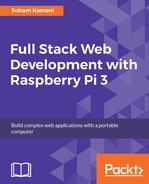The Raspberry Pi has become hugely popular as a portable computer, and for good reason. When it comes to what you can do with this tiny piece of technology, the sky's the limit. Back in the day, computers used to be the size of entire neighborhood blocks, and only large corporations doing expensive research could afford them. After that, we went on to embrace personal computers, which were still a bit expensive, but, for the most part, could be bought by the common man. This brings us to where we are today, where we can buy a fully functioning Linux computer, which is as big as a credit card, for under $30. It is truly a huge leap in making computers available to anyone and everyone.
The marvel of the Raspberry Pi, however, doesn't end here. Its extreme portability means we can now do things that were not previously possible with traditional desktop computers. The GPIO pins give us easy access to interface with external devices. This allows the Pi to act as a bridge between embedded electronics and sensors and the power that Linux gives us. In essence, we can run any code in our favorite programming language (which can run on Linux) and interface it directly to outside hardware quickly and easily. Once we couple this with the wireless networking capabilities introduced in the Raspberry Pi 3, we gain the ability to make applications that would not have been feasible to make before this device existed.
Web development and portable computing have come a long way. A few years ago, we couldn't dream of making a rich, interactive, and performant application that runs on the browser. Today, not only can we do that, but we can also do it all in the palm of our hands (quite literally). When we think of developing an application that uses databases, application servers, sockets, and cloud APIs, the picture that normally comes to mind is that of many server racks sitting in a huge room. In this book, however, we are going to implement all of that using only the Raspberry Pi.
In this chapter, we will go through the concept of the Internet of Things and discuss how web development on the Raspberry Pi can help us get there. Following this, you will also learn how to set up your Raspberry Pi and access it from our computer.
We will cover the following topics:
- The Internet of Things (IoT)
- Our application
- Setting up the Raspberry Pi
- Remote access
